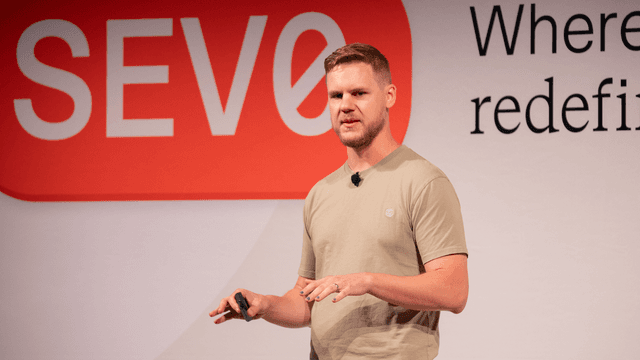The 9.1 magnitude meltdown at Fukushima
This talk explores how the Fukushima Daiichi nuclear disaster unfolded, focusing on leadership under crisis, heroic actions, and the generative culture that helped prevent an even greater catastrophe.

Nickolas Means, VP of Engineering, MedScout, Managing Up Podcast
talk
The transcript below has been generated using AI and may not fully match the audio.
Welcome back from lunch, everybody. Hope you all had some good food, some good conversation, hopefully made some new friends. my name is Nick. I lead engineering at an early stage startup called MedScout. So I'm not here today to share any great first hand lessons about managing incidents at scale.Some seriously startup, not huge incidents. I can tell you about the time that GitHub repositories page, if you want to ask me about that later, but not today. instead I'm here as an amateur historian and a storyteller. I think we as engineers have a lot to learn from stories from other engineering disciplines.And the story of Fukushima is an incredible one. So dotted along the coast of Japan, usually a significant distance from the water are stones like this, left there by anonymous members of previous generations, and they all say something similar to this one. A home built high is children's relief.Remember the disastrous giant tsunami. Do not build homes below here. Now, Japan is one of the most seismically active countries on Earth, built on the Pacific Ring of Fire. These stones make it obvious that they're also no strangers to tsunamis, massive ocean waves driven by earthquakes under the sea. given the risk of tsunamis, you might be surprised by this map of nuclear power plants in Japan.Every single one is right on the coast. Why is that? when you picture a nuclear power plant, what pops to mind? It's probably something like this. And credit to the Simpsons, this actually is a fairly accurate rendering of a pressurized water nuclear power plant. The thing in this picture you most likely associate with nuclear power, though, are the two hyperboloid cooling towers standing tall over the rest of the plant.Now, the funny thing about this is that there's nothing inherently nuclear about them. Every thermal power plant needs a source of cooling, and there are plenty of non nuclear power plants around the world that use hyperboloid cooling towers. And plenty of nuclear plants that use other kinds of cooling like these mechanical draft arrays in the middle of the Arizona desert.The post war economic boom in Japan meant that by the 1970s Japan was starving for electricity. And when you need to build a bunch of power plants in a hurry and on a budget, one of the best ways to reduce time and cost is to build them on large bodies of water. This lets you use the body of water as a giant heat sink so you actually don't need a cooling tower.It's a whole part of the plant you don't even have to build at that point. And that's what Japan did over and over again. One of those plants on the sea with no cooling towers is Fukushima Daiichi, a six unit boiling water nuclear power plant with a generating capacity of 5. 3 gigawatts, owned and operated by the Tokyo Electric Power Company or TEPCO.It's located right on the Pacific coast in Northeast Japan. The reactors at Fukushima Daiichi all went online between 1971 and 1979, all of them boiling water reactors designed by General Electric. March 11th, 2011 started out like any other day at the plant. Units 3 were all running, as they say in the nuclear industry, hot, straight, and normal, running at full power, producing their full electric load.Unit 4 was offline being refueled, and 5 and 6 had just completed a refueling cycle and were being tested in preparation for a restart. But off the coast of Japan, in the Earth's crust, trouble had been brewing for more than a thousand years. As the Pacific plate continually subducts under the Okhotsk plate that Tohoku and the rest of northeastern Japan sit on, potential energy is built up like a spring being compressed.And in this case, the epicenter was about 45 miles off the coast. On March 11th, 2011, at about 2. 46 in the afternoon, that potential energy finally overcame the friction holding it back and became kinetic energy in the form of a magnitude 9. 1 earthquake. The epicenter is about 45 miles off the coast, but subduction zone megathrust earthquakes like this one typically involve a rupture along several hundred miles of fault line.And in this case, the fault line that ruptured roughly parallels the northern coast of Japan. The force of this rupture was such that northern Japan moved about 8 feet closer to North America, and the tilt of the Earth's axis shifted somewhere between 6 and 10 inches. It was the most powerful earthquake to ever strike earthquake prone Japan.When the shaking started, Masao Yoshida, the director of Fukushima Daiichi, was in his office processing some of the paperwork that was ubiquitous in the TEPCO bureaucracy. Yoshida kept expecting the shaking to taper off, but it just got stronger. For six long minutes, the ground kept shaking. When it finally stopped, Yoshida threw on his hard hat and ran out of his office, headed towards the plant's earthquake proof emergency response center, where he would spend the next several days.The control room for units one and two was in disarray right after the quake. As the shaking stopped, the operators immediately ran to the panels and started figuring out the state of the plant, calling out various measurements to Ikuo Azawa, the shift supervisor that day. They were able to quickly see that the plant's automated emergency systems had done exactly what they were supposed to do.And to understand what happens next, you need to know a little bit about how nuclear reactors work, so let's do a quick crash course. The heart of any thermal power plant is the heat source. In a nuclear reactor, it's the uranium fuel rods that create the heat generating nuclear chain reaction. The fuel rods are contained in a pressure vessel and surrounded by water that, in a boiling water reactor, boils into steam.There are also neutron absorbing control rods that can be inserted to slow or stop that nuclear chain reaction. As water boils to steam at the top of the reactor vessel, it expands, and the energy from that expansion drives a turbine connected to a generator. This is how any thermal power plant generates electricity.After the steam turns the turbine, it's directed into a condenser where it cools and turns back into liquid water. And then there's a circulation pump to send the cooled water back up into the bottom of the reactor pressure vessel to cool the fuel and to replace the water that's continually boiling off at the top.At Fukushima Daiichi, like most nuclear plants, there are sensors to detect earth movement. Whenever there's an earthquake, the reactor control system automatically scrams the reactor, driving the control rods all the way into the nuclear pile. And stopping the chain reaction instantly. And this happened exactly as it was supposed to in the three reactors that were running that day.But the fuel in a nuclear reactor gets so hot that cooling circulation must be maintained for days after shutdown to continue carrying heat away so that the fuel rods don't melt. That means that the reactor circulation pumps must be kept running. And that's a problem when a giant earthquake has severed your plant's connection to the electrical grid and you're not generating any power on your own.Now, thankfully, the plant had redundant answers to this situation. First, each of the reactor units has two enormous backup diesel generators, just one of which provides adequate power to maintain circulation in the reactor core. These generators had all started up automatically as soon as the plant lost its grid connection.And in case the generators failed, each control room also had a bank of lead acid batteries to power instrumentation and control valves for several hours. Second, each reactor had a passive cooling mechanism that would function without any external power at all. In Unit 1, that took the form of an isolation condenser.Steam from the reactor pressure vessel could be directed through a heat exchanger in the isolation condenser, where it would turn back into liquid water, and then flow by gravity back into the bottom of the pressure vessel. The isolation condenser could passively cool the reactor for three days without any intervention.The other units had passive cooling systems as well, and each of them started up automatically alongside the backup generators. At this point, despite being without any power from the electrical grid,When the first tsunami warning went off a few minutes after the quake, the initial prediction for the Fukushima area was just 50 centimeters, around 18 inches. That would be revised several times, but never beyond the plant's 19 foot seawall. They made a precautionary announcement over the plant PA that a tsunami was coming and that personnel should move to higher ground, but there wasn't any particular urgency about it.The largest of the three tsunamis headed towards the plant was more than 40 feet high, double the height of their seawall, and it was moving towards them at 100 miles an hour. When it arrived, the operators in the windowless control room had no idea. They were shocked when one of the operators announced a new critical alarm at 3.37 p. m. The diesel generators have tripped. A few seconds later, the overhead lights in the control room went out. Then slowly, randomly, panel by panel, their instruments flickered and went dark. The constant warbling of alarms from the unhappy plant was replaced by an eerie silence. A few seconds later, Izawa broke the silence by shouting, station blackout!They had no electricity at all. A situation considered so impossible given their redundant safety mechanisms that they had no realistic contingency plans for it.So what had happened, the reactors at Fukushima Daiichi are all located 10 meters above sea level, well above the height of the tsunami. The huge diesel backup generators, along with the power switching equipment and the lead acid batteries, were all in the basement of the auxiliary building on the four meter level of the plant.So when the tsunami arrived, they were all flooded. The operators found themselves trying to operate three nuclear reactors that just minutes before had been generating over two gigawatts of electricity. with no instrumentation and no remote control valve operation. Their immediate concern was Unit 1.In order to protect the reactor's pressure vessel, cool down rate couldn't exceed somewhere around 55 degrees Celsius per hour. That's what their runbook told them, the plant's instruction manual. Because if it cooled down faster than that, you risked cracking the giant metal pressure vessel, rendering the reactor inoperable.About 20 minutes after the quake, the operators realized that it was cooling down too fast. And so they had begun cycling the isolation condenser in and out of the loop so they could slow down that rate of cooling. They had just cycled the condenser back off at 3. 34 p. m., three minutes before they lost power.The passive cooling systems in Unit 2 and 3 would keep them under control for the time being, but Unit 1, because of unlucky timing, was completely without a mechanism for cooling the core. Without coolant circulating to carry heat away, all of the water in the core will boil to steam. And this causes a couple of things to happen.First, without cooling, the nuclear rods will eventually get so hot from all that decay heat left over from producing electricity that the fuel will start to melt. This is, when you say a meltdown, that's literally what you mean, is that the nuclear fuel in the reactor is starting to melt. Second, because water expands when it turns to steam, the pressure in the pressure vessel rises.And if pressure gets high enough, it will eventually turn into a giant steam bomb and explode, spraying radiation into the environment. Given Fukushima's location, that could make Tokyo uninhabitable for decades. And that fact was in the back of everybody's mind.Now there were a few things they needed to do to get Unit 1 back under control, and they started working on them all at the same time. They knew the instruments in the control room would work under DC power, so while one team began looking at wiring diagrams, another team went outside to scavenge batteries out of the cars that had been strewn about by the tsunami.Meanwhile, another group had an idea to re establish cooling by using Unit 1's firefighting pipe network to route water directly into the core. A pair of operators headed into the dark reactor building to manually turn the five valves necessary to route the water from the fire pipes into the core, and they accomplished their mission, making it back to the control room at 9 p.m. By 11 p. m., radiation levels at the reactor airlock were so high that further entry was prohibited by Masao Yoshida. So it was fortunate that this was one of the first things that the operating crew did. By 2 a. m., they had a fire engine connected, pumping water into the core, trying to reestablish cooling.But water injection was very slow. Once they finally had some rudimentary instruments online from the scavenged car batteries, they understood why. Pressure in the pressure vessel was significantly elevated, about two atmospheres, and the fire engine was struggling to pump water against all of that pressure.They knew that the only way the pressure would be this high was if the fuel had begun melting. So relieving the pressure to get more water in and prevent more fuel from melting was urgent. Now, thankfully, Yoshida had anticipated this when he was already working on the necessary permissions to conduct a vent.And this is exactly what it sounds like. A nuclear reactor is a closed loop system. So in order to relieve that pressure, you have to vent some of the radioactive steam out into the surrounding environment. And under Japanese law, any atmospheric release of radiation required government permission. And that permission needed to come from this man, Naoto Kan, the Prime Minister of Japan, straight from the top.Now, Kahn readily gave permission for the vent as soon as the five kilometer evacuation zone around the plant was evacuated, a process that was already underway. At the plant, Izawa and his team had begun working feverishly in rapidly deteriorating conditions to figure out how to vent the reactor.Remember, they had no remote valve control at this point. Radiation levels were now high enough in the control room that being there required wearing full face masks with charcoal filters. If radiation levels were this high in the control room, they would be far worse in the reactor building. They had to figure out a way to vent that would have staff in and out as quickly as possible.Meanwhile, back in Tokyo, Khan had finished his middle of the night emergency press conference to announce the vent, and he was livid. It was 4 a. m., he had given his permission to vent long ago, and as a trained engineer, he knew full well the potential consequences of rising pressure. Why hadn't the vent been done yet?Now Tepco had sent a liaison to his office and they had tried explaining the challenges that staff at the plant were facing, but Khan decided he needed to see what was going on for himself. at 5. 30 the next morning, this is the day after the earthquake and the tsunami, the PM and his entourage were in a helicopter on the way to Fukushima Daiichi.When Han's helicopter landed, TEPCO Vice President Takaya Muto was among the party to greet him. And Muto remembers offering Han a standard formal Japanese business greeting, some long lines of, It's very kind of you to come, sir. And Han responded by yelling, Why the hell haven't you vented yet?And he proceeded to yell at Muto for the full bus ride to the Emergency Response Center. We met Yoshida at the ERC. Han's anger continued. He greeted Yoshida by yelling, What the hell is going on here? And rather than fight fire with fire, Yoshida calmly explained the situation in detail, and as he talked, Kahn seemed to settle.Finally Kahn asked, when are you going to get the vent done? More than anything, you must get the vent done. And Yoshida responded, we are of course doing everything that we can. We have a suicide squad preparing to enter the radiation field now. Now hearing that people were willing to risk their lives to conduct the vent operation, end of the discussion.And despite all of the distractions that are to cause, the need to source protective equipment, the need to find a safe path to transport them from where the helicopter could land to the emergency response center, the actual meeting between Yoshida and Khan had lasted less than 20 minutes. I'm sure we've all experienced a CEO in an incident room that felt about like that.Meanwhile, Izawa's crew identified a pathway to venting that would require only operating two valves. The valves were in two different areas of the reactor building, so they send two teams of two men apiece into each area. Under Japanese law, workers are allowed a maximum of 100 millisieverts of radiation during an emergency.The regular limit is 50, during an emergency it goes up to 100. So everyone put on a personal disseminator alarm like this one and set it to go off at 80 millisieverts, agreeing to turn back immediately if that alarm were to go off. The first crew made their way to their valve on the second floor of the reactor building.It was huge, it was awkwardly placed, they had to get a rod to get leverage on it to get it to start turning. But they got it done, and they were back in the control room 11 minutes after they had left, without coming anywhere close to their radiation limit. The second crew's valve was in a much more precarious position.To help us understand, here's a photo of an under construction Mark I containment structure. The thing represented in this diagram from earlier, you can see the resemblance there. The second team's valve was in the basement of the reactor building. Now, if there had been core damage, that melted fuel would be sitting at the bottom of the pressure vessel, creating an intense radiation field at the bottom of primary containment, right above where this valve they needed to turn was.As they made their way into the basement, the handheld radiation meters they were carrying, in addition to their personal dosimeters, suddenly jumped to a thousand millisieverts per hour. the maximum that they could read. So they had no idea how high that radiation field actually was, it maxed out their meters.And so they quickly turned back and got back to the control room. When they got back, they found that they had received doses of 89 and 95 millisieverts respectively, just from the very brief time they'd been in that radiation field. They were the first two workers to dose out and have to be evacuated from the site.So now it's nearly 10 a. m. the day after the accident and the vent still hasn't been carried out. The operators had gone from elated at the first cruise success to despondent at the second cruise discovery. But they didn't give up. They knew there had to be a way to vent it. One team worked to see if there was any way to hook up a portable air compressor to operate the valve pneumatically, while another looked at schematics and diagrams and plant maps to see if there was any other way to get to this valve that might carry them through a different area that wasn't quite so radioactive.By 2 in the afternoon, the reactor pressure was up to 8 atmospheres, double the rated strength of the pressure vessel. Things were getting desperate. Another crew was just getting ready to make a run for the valve, determined to open it no matter the cost, when they got a call from the emergency response center.White smoke was coming out the top of Unit 1 and 2's shared vent stack. Slowly, pressures in the reactor started to drop. They had to be venting, there was no way they could have known it without instrumentation to tell them valve positions, but the attempt to open the valve pneumatically must have worked.They felt a tremendous sense of relief, but it would last for less than an hour. This is what an off site monitoring camera saw at 3. 36 p. m. that afternoon. Workers scrambled to put on protective gear to figure out what had happened. Their initial fear was that venting the reactor was too little too late, and that the reactor pressure vessel had just exploded, but thankfully that wasn't what had happened.The fuel rods from most nuclear reactors are tubes made of zirconium alloy and filled with uranium fuel pellets. Zirconium is the metal of choice for this application because it's very corrosion heat resistant while also being basically invisible to the neutrons that fly around and sustain the nuclear chain reaction.As the core gets hot enough to melt though, zirconium starts to rapidly corrode. And in a reactor pressure vessel filled with steam, this sudden corrosion rips the surrounding water molecules apart. forming zirconium oxide and hydrogen gas. As the smoke and the debris settled, this is what they saw. Given the shaking and the over pressurization, it's likely there were plenty of places the hydrogen created by the meltdown could have slipped through.It accumulated at the top of unit one's containment building and all it took was one spark from somewhere. The explosion blew radioactive debris across the site. It also caved in a door at the emergency response center containing the one relatively radiation free space remaining on site. The work of keeping units 2 and 3 from melting down got that much harder.And the situation at unit 3 was getting critical. The passive cooling system had been cooling the reactor since the power loss, but heat was starting to build, and they were starting to run out of fresh water on site. So the team made the call to begin injecting seawater, and they'd been trying to avoid this because it would make the reactor inoperable, it would ruin the reactor and never be able to start it up again.But at this point, it was more critical to keep it from exploding.Back in Tokyo, the Prime Minister demanded that they not begin seawater injection. One of his small group of technical advisors had mentioned a non zero chance that the salt in the seawater might cause the reactor to go critical and start reacting again. In reality, that chance was minuscule and an exponentially lower risk than a pressure explosion, but Khan was insistent that they investigate further before they started injecting seawater.Yoshida had no intent of complying. Before the video conference with TEPCO executives in Tokyo began, he told his staff, he knew it was coming, if they ordered me to halt seawater injection, I will relay the order to you so that they can hear me. You were not to respond, and you were not to stop seawater injection.It's our only chance. Unbeknownst to them, core damage at Unit 3 had actually already occurred, and if they had stopped the seawater injection, Reactor pressure would have continued to climb and it's very possible that an explosion would have occurred. The next day, Unit 3 would experience its own hydrogen explosion, just like Unit 1.Unit 4, which wasn't even running at the time of the earthquake, would also go on to explode from hydrogen gas, probably leaking over from Unit 3. Unit 2 experienced core damage as well. And it likely avoided a hydrogen explosion only because its reactor building was damaged enough in the other explosions that hydrogen couldn't even accumulate.You can see units one through four in this photo, with three of the four having experienced a hydrogen explosion and three of the four in a state of partial meltdown. At this point, radiation levels at the site were making it hazardous to walk from building to building with staff running in protective gear anywhere they had to go.So late in the evening of the 14th, Yoshida made the difficult decision to evacuate most staff to Fukushima Daini, Daiichi's sibling plant a few miles away, and only keep a volunteer skeleton crew on site. Everyone who chose to stay knew that there was a significant chance that they'd suffer dangerous radiation exposure, possibly even die, but they felt a responsibility to the rest of Japan to make sure the plant didn't cause wider contamination.In the end, there were 68 plus Yoshida left at the plant. The media gave them the nickname, the Fukushima 50. back in Tokyo, Prime Minister Khan hears that Tepco plans to abandon the plant. Furious at this news, Khan calls a middle of the night meeting. Again, the Tepco liaison steps in, quickly clarifies the misunderstanding.But it doesn't seem to matter to Khan. He's livid. He uses his authority to create a joint response office with himself as the head. Taking over control of the responsive Fukushima from teco. And despite knowing that there was never any intention to actually abandon the plant, Kahan carries on in the meeting like there was, if things go on like this, Japan is done for abandoning the plant is unthinkable.You must risk your lives on it if necessary. If you abandon the plant, TECO will be destroyed. You can run, but you can't hide. To a room full of people, who had just decided to sacrifice their lives, if necessary, to keep the plant from exploding, Kahn said, you can run, but you'll never get away. at this point, Masao Yoshida had enough.At the front of the room, video conference camera still running, Yoshida stands up, turns his back to the camera, and drops his pants.Now, he makes it look like he's just tucking his shirt back in, but everyone in the room knows what he's really doing. In Japan's formal business culture, turning your back on a superior is a sign of disrespect. Fact. A huge etiquette faux pas. But Yoshida took it a step further than that. As the plant slowly came further under control and danger became less, evacuated workers came trickling back in to help.It would take the better part of the year, but finally on December 16th, TEPCO was able to declare a cold shutdown at Fukushima. All reactors were below 100 degrees Celsius, and all radiation leaks had been substantially contained. This photo from last year shows the condition of the plant today. A tank farm sprang up around the plant to contain all of the contaminated water it had taken to cool the reactors.Unit 1 and 2's buildings were able to be repaired, but new containment structures had to be built around Units 3 and 4. Decommissioning work has begun and will likely take several decades to complete. In the history of commercial nuclear power generation, there have only been five nuclear reactor meltdowns.Three of them at Fukushima Daiichi. But to fully understand the severity of the accident, let's put it into context by comparing radiation release. The first commercial reactor to partially meltdown was at Three Mile Island in Susquehanna, Pennsylvania. Three Mile Island's contained hydrogen explosion and subsequent venting released approximately 626 gigabecquals of radiation into the atmosphere.Seems like a lot, right? Fukushima Daiichi, with its three partial meltdowns, three uncontained hydrogen explosions, is estimated to have released 780 petabecquels of harmful radiation. Three Mile Island is represented as a one pixel dot on this screen. I promise it's actually there. But the correct size would actually be a circle six ten millionths of a pixel across.That's how much smaller Three Mile Island was than Fukushima.But even that's tiny compared to the biggest reactor disaster of all time, Chernobyl. The Soviet RBMK reactor design famously had no containment of any kind. So when it exploded, the lid of the reactor literally flew right off, spraying radiation into the atmosphere to the tune of 5. 2 exabecquerels, about seven times as much as Fukushima.But let's say, that the operators at Fukushima had failed to re establish cooling and relieve the growing pressure in their reactor pressure vessels, and that all three running units had experienced steam explosions. What would that look like? An uncontained failure at all three active Fukushima Daiichi units would have released at least 7.5 exabecquerels of radiation. But because Fukushima's reactors had pressure vessels, it's likely that would have amplified the explosions versus what we saw at Chernobyl. They would have been pressure bombs. It's almost impossible to know how bad it could have been if not for the heroic actions of Masao And all of the others who risked their personal safety to respond to the situation.The only way the disaster at Fukushima could have been prevented was to move the backup generators to higher ground. Something that, in true bureaucratic fashion, TEPCO was studying, but hadn't yet committed to doing. Once the tsunami arrived, though, there's very little the operators could have done better, given the information and resources and instructions that they were working from in the minutes, hours, and days after the accident.We think of Fukushima Daiichi as a disaster, and it definitely was. There's a large portion of Japan that's still uninhabitable because of what happened here. But when you look at it in the context of what might have been, it was also an incredible success. So instead of learning from what went wrong, let's look at what went right.In a very hierarchy driven society, in the middle of a bureaucrat's bureaucracy at TEPCO, and with the Prime Minister breathing down their necks, the operators at Fukushima were able to think and operate decisively to bring the plant back under control. How? To understand that, let's dig a little into how organizations actually function.This really interesting paper published by Dr. Ruthann Heising is where we'll start. Dr. Heising studied business process redesign teams at several large companies. These teams were trying to make fundamental improvements to how their organization accomplished critical tasks. And where each team started was process mapping.Documenting the steps, conversations, tools, and other activities required to do something like process an insurance claim, or launch a new physical product into the market. This is an example of one of the maps from Dr. Huizing's exercises. Now, these maps always surprised the teams that made them, and they often raised existential questions, especially for people with leadership titles.The reason was that they revealed the actual structure of the organization, the relationships and the information pathways that were responsible for the organization getting work done. To quote Dr. Huizing, they learned that what they had previously attributed to the direction and control of centralized bureaucratic forces was actually the aggregation of the work and decisions of the organization.of people through, distributed throughout the organization. It's easy to assume that folks in formal leadership roles are in control. Some of us are in these roles right now. Some of us aspire to them because we think we need formal titles with more control to make some of the changes to organizations that we want to make.But Dr. Huizing's work tells us that control is not exactly what these roles give leaders. A title conveys formal authority, of course, but all of the output of an organization happens at the bottom of the org chart. This is where the organic emergent structure by which an organization actually gets work done exists.That means that any control that you think that you have in your job, especially if you have a leadership title, is actually an illusion made up of two other things. The first is power. Depending on your role, your formal authority might give you control over people's pay, what projects they get to work on, even if they get to continue having a job.And this power can give you a lot of leverage in getting people to do what you want them to do. The other is influence. Influence is using the relationships that you build, the expertise that you display, and the behaviors that you model to engender trust in the people that you work with, to align them with the mission, and win them to your cause.Every leader uses a combination of power and influence to get their job done, but the two tend to be inversely correlated. The more influence you use to lead, the less power you use, and vice versa. So let's take a look at the two leaders in our story and put them on a spectrum. But instead of using my spectrum, let's use Ron Westrom's.In a 1998 paper, Dr. Westrom proposed a typology for categorizing organizations based on how information flows through them. Is it pathological? Constrained to be used as a tool to control others? Is it bureaucratic, following a set of rules sometimes designed to protect a specific department at the expense of the whole?Or is it generative, where information flows freely to advance the whole organization's goals and generate new ideas? Westrom focused on the flow of information because, in his words, information provides the glue that keeps teams focused and coordinated. In his research, Dr. Westrom found that the influence of leaders was most evident at the extremes, and that bureaucratic organizations were a sort of unfortunate default.for the sake of this discussion, we're going to ignore bureaucratics. What are some of the characteristics Westrom identified in pathological and generative leaders in the organizations that they build? pathological leaders build cultures with low levels of cooperation by making sure all decisions flow through them.Generative leaders, on the other hand, encourage cooperation by delegating decisions and authority to those closest to the situation. Pathological leaders tend to shoot messengers, yelling at them for not solving the problem. Generative leaders, on the other hand, encourage messengers. Making sure they learn of problems and challenges as quickly as possible so that they can act on them.When something goes wrong, pathological leaders make sure they know who to blame so that they don't get blamed themselves. Generative leaders aren't worried about blame. They want to understand what's happened so that they can respond to it and learn from it. And finally, pathological leaders see new ideas as a threat to them and their control.Generative leaders try to get their whole team into the idea generating business because they know they don't have a monopoly on good ideas. What's interesting about Westrom's typology, especially for those of us in this room, is that while we usually see it applied to organizations as a whole, it initially emerged from Dr.Westrom's research on trauma teams, the ad hoc, multidisciplinary groups that come together in trauma situations to address an emergent condition. Now, I'm betting the words ad hoc, multidisciplinary, and emergent Made some of yours perk upWestern found that teams with generative cultures consistently achieve better outcomes than their peers, especially in times of crisis because they trust each other. Information and resources flow freely, and they respond in emergencies without worrying about who gets the credit of things go right or the blame if they go wrong.The generative culture that Meida spent years building at Fukushima Daiichi. is the reason that the operators were able to creatively solve so many problems happening at the same time. So how did he do it? Ryusho Kodota, the author of one of the books that I read while researching this presentation, asked several of the operators at Fukushima how the accident would have been different without Yoshida.And most of them answered with some variant of, We'd have been lost without him. Several said something like, With Yoshida in the lead, we were prepared to die together if we had to. When asked why, it came down to trust. Not their trust in Yoshida's trust in them. His teams were able to make decisions, improvise solutions, work in deep harmony during the accident, because of the trust that he placed in them and helped them build in each other.Yoshida continually re earned and reinforced that trust. By doing things like standing up to the Prime Minister, In managing TEPCO leaders in Tokyo, making time and space for his team to respond to the events that were actually on the ground in front of them. If you want to build this kind of culture where you work, it starts by embracing the idea that no matter your role, you're not actually in control.You're just wielding power and building influence to shape behavior and action. You have to decide where you want to land on this spectrum. And if you want to build degenerative culture, Westrom's research tells us there's a pretty clear answer. Now, that's not to say that all power is pathological. Andrew said this morning, sometimes you do have to use power in order to build safety.Thank you. But in general, if you want to build a generative culture, you should aspire to lead by being a leader worth following. You have to build trust, share context, build buy in, encourage and motivate rather than just telling people what to do. It means actively giving your power away to those around you, creating space for them to try things, make mistakes, and learn.And the good news is that you can find ways to do this no matter what seat you sit in and no matter what formal title you have. This was the secret of Yoshida san. He was a leader worth following. And it's not an overstatement to say that the generative culture that he and the leaders on his team built quite literally saved Tokyo.If he could build generativity amidst the Japanese culture of extreme deference to hierarchy and the stifling bureaucracy of TEPCO, there's absolutely nothing stopping us from doing the same thing. Thanks.San Francisco 2024 Sessions

Keynote: the evolution of incident management
 Stephen Whitworth, Co-founder and CEO, incident.io
Stephen Whitworth, Co-founder and CEO, incident.io
View session
Maintaining blameless incident culture when everyone knows whodunnit
 Andrew Guenther, Member of Technical Staff, OpenAI
Andrew Guenther, Member of Technical Staff, OpenAI
View session
Organization-aware incident response
 Lawrence Jones, Product Engineer, incident.io
Lawrence Jones, Product Engineer, incident.io
View session
Building processes that survive contact with reality
 Colette Alexander, Director of SRE & Observability, HashiCorp
Colette Alexander, Director of SRE & Observability, HashiCorp Dawer Jung, Game Reliability Manager, Netflix
Dawer Jung, Game Reliability Manager, Netflix Uma Chingunde, Engineering Leader, ex Render, Stripe
Uma Chingunde, Engineering Leader, ex Render, Stripe Chris Evans, Co-founder and CPO, incident.io
Chris Evans, Co-founder and CPO, incident.io
View session
Stop, Drop, and SEV4: Why small incidents are a big deal
 Derek Brown, Service & Network Platform Lead, Plaid
Derek Brown, Service & Network Platform Lead, Plaid
View session
The 9.1 magnitude meltdown at Fukushima
 Nickolas Means, VP of Engineering, MedScout, Managing Up Podcast
Nickolas Means, VP of Engineering, MedScout, Managing Up Podcast
View session
There is no such thing as a free lunch. How Slack runs their incident lunch exercise
 Scott Nelson Windels, Engineering Manager, Slack
Scott Nelson Windels, Engineering Manager, Slack
View session
Balancing reliability whilst scaling fast
 Tom Blomfield, Partner, Y Combinator
Tom Blomfield, Partner, Y Combinator Mel Good, Senior Exec Director of Reliability, JPMorgan Chase & Co.
Mel Good, Senior Exec Director of Reliability, JPMorgan Chase & Co. Stephen Whitworth, Co-founder and CEO, incident.io
Stephen Whitworth, Co-founder and CEO, incident.io Paul Williamson, Start-Up Advisor & Investor, ex Plaid, Visa, Salesforce
Paul Williamson, Start-Up Advisor & Investor, ex Plaid, Visa, Salesforce
View session
Culture over chaos: Fostering a positive On-call environment
 Ryan Schroeder, Senior Software Engineer, Netflix
Ryan Schroeder, Senior Software Engineer, Netflix
View session
